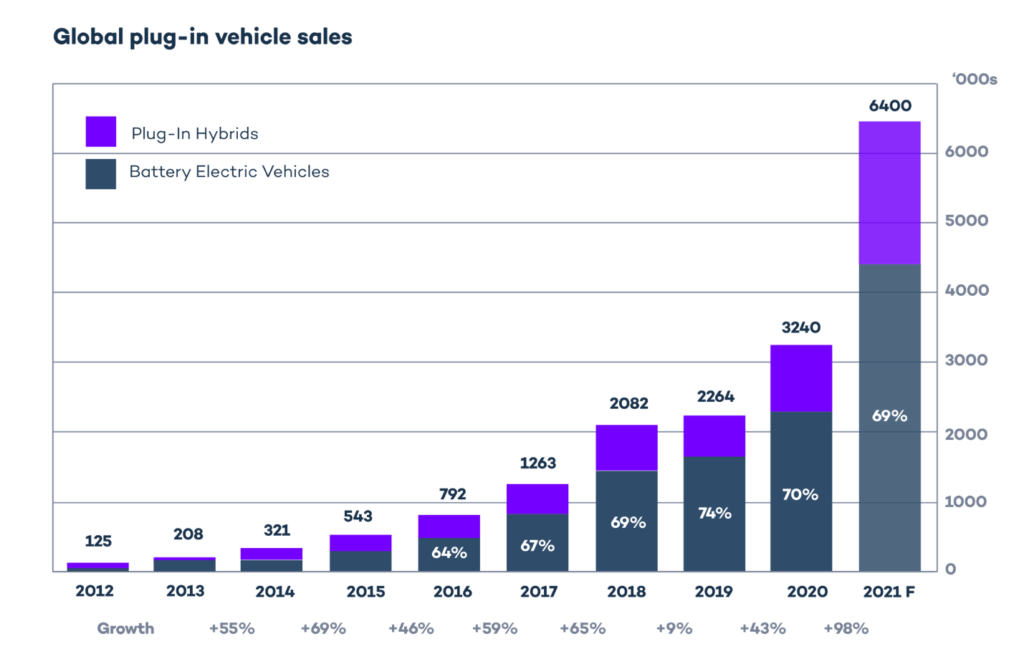Ecological trends facing business in 2022 and beyond

Editor’s note: This article is part of an annual four-part series on trends impacting small and midsize businesses. In Part 3, we study ecological trends for 2022.
While at the Conference of the Parties (COP26) Summit, U.S. President Joe Biden shared his frustration with the notable absence of Russian President Vladimir Putin and Chinese President Xi Jinping. The conference, attended by 200 world leaders, is in its 26th year, and has historically produced meaningful mandates, protocols, platforms and agreements. The undercurrent at this year’s conference was an acknowledgment that the world has fallen behind commitments made at the Paris Accord, passed in 2015 with the aim of limiting rising temperatures to 2 degrees above pre-industrial levels.
During the conference, Congress sent President Biden the first meaningful U.S. legislation on “climate resilience” to prepare local governments for the devastating impacts of large-scale weather events. In the final days of the conference, three agreements were announced:
- The United States and China agreed on a pact to decrease methane emissions, reduce coal consumption and eliminate deforestation. This is a significant step forward in the fight against climate change, as China and the U.S. remain the globe’s largest polluters.
- On the very same day, GM, Ford and Volvo announced a pledge to eliminate gas-powered automobiles by 2040.i Rebuilding the world’s transportation and energy infrastructure was a key discussion point in Glasgow. Pressure on other automakers is mounting.
- In the eleventh hour, COP26 attendees announced a compromise. Sticking points were phasing out coal, fossil fuel subsidies, and support for developing countries that cannot keep pace in the fight against climate change. Critics of the accord say it doesn’t go far enough, but attendees viewed it as humanity’s best chance to keep the goal of 2-degree improvement viable. ii
As of this writing, Congress is considering another $300 billion in funding which would provide tax incentives for expanding clean energy, including significant federal subsidies for electric vehicles. iii
Below we will review the impacts of climate change, and how businesses can become better stewards of the environment:
Other 2022 trends
Part 1: Social trends facing business in 2022 and beyond
Part 2: Technology trends facing business in 2022 and beyond
Part 4: Economic trends facing business in 2022 and beyond
Global climate trends
Climate change economics: Until recently, fossil fuels have been significantly cheaper than renewable energy. Companies have invested $22 trillion in current and future fossil fuel projects. As renewable capacity expands in countries like the U.S. and China, costs are reduced, which will only accelerate adoption. The cost of wind and solar has dropped about 80% over the last decade.
Weather events: Climate disasters have cost over $100 billion in 2021 in the U.S. alone, killing 538 people through September.iv There was a record number of billion-dollar disasters, including Hurricane Ida, tropical cyclones, floods, droughts, wildfires and winter cold waves. The insurance market is resetting, with fire insurance unavailable in some parts of California.
Nationally determined contributions (NDCs): Commitments made by participating nations (known as NDCs) have fallen short to date. Pledges of over $100 billion to move to clean energy have not materialized. There is movement toward standardizing rules on carbon emissions so counterparties can easily purchase “offsets.” Offsets are going mainstream, with companies doing things as simple as planting trees and dedicating open spaces.
Population growth: is a culprit of climate change. In addition to demanding more energy, urban sprawl puts more strain on water and sewer systems. Trash removal is a crisis in many large cities.
In Asia, 1.5 billion people live in the tropics (hundreds of millions of them near eroding coastlines) and are subject to severe weather events.v Some of the world’s most populous nations, such as India, have refused to agree to carbon neutrality.
Coastline erosion is extreme in Hawaii and California. A recent road failure in Big Sur, California, prompted the state to move the scenic Highway 1 further inland.
Biodiversity: It is estimated that the cost of biodiversity loss is $2.7 trillion, including loss of land, fish stocks, and more meaningful loss of species used by scientists to create medicines and vaccines.vi
Water: Over 800 million people worldwide do not have access to freshwater.vii National Geographic estimates that by 2025, 1.8 billion people will live in areas with severe water scarcity. By this time, global agriculture will require an additional 1 trillion cubic meters of water annually. UN studies project that 30 nations will be water-scarce in 2025, up from 20 in 1990. Severe drought conditions have returned in the West.
The transition from fossil fuels to renewables
Electric vehicles: For most Americans, the adoption of EVs is the most tangible way to directly impact the environment. Amid growing access to long-range batteries and battery stations, EVs are exploding on the market, with sales up a whopping 98% in 2021. And that’s before a glut of new releases in 2022 by almost every carmaker. Volvo and others are moving toward “remanufacturing” with used parts.viii
Global EV Unit Sales

New applications for solar and wind: Congress is considering new tax credits for solar which will dramatically increase adoption. There are also new applications including many standalone restaurants and detached buildings.
Coal and methane: The compromise at the COP26 was reached after tense negotiations over India’s unwillingness to “phase out” coal (among the cheaper energy sources) in the next twenty years. In the midst of a global energy crisis sparked by a severe natural gas shortage, some countries have reverted back to their dependence on coal. In Colombia, for example, coal emissions will be up 40% this year.ix The production of meat is a large contributor to the release of methane. Methane is a much stronger greenhouse gas than carbon dioxide, even though it doesn’t last in the environment as long.
The Biden administration has proposed new rules that expand oversight of natural gas pipelines, as part of a push to curtail U.S. methane emissions by 41 million tons by 2035.x
World energy consumption by energy source

Sustainability industry trends
Agriculture: Producing food currently generates 26% of greenhouse gases and consumes 66% of the world’s water.xi Greater consumer awareness sparked a 140% increase in U.S. consumption of meat alternatives as Americans shift toward veganism and plant-based diets. Grocery delivery systems that focus on sustainability such as Imperfect Foods are growing in popularity.
Fashion: The era of throwaway fashion is threatened by changing consumer preferences. A BCG study found that 38% switched brands based on sustainability practices.
Manufacturing: U.S. manufacturers alone produce more than 7.6 billion tons of industrial waste per year. Companies are adopting more holistic environmental design practices and considering environmental impacts in their supply chain.
Packaging: The packaging industry is moving past recycled materials to compostable as consumers demand more sustainable materials, and regulatory agencies enact more controls over the claims that producers can make on their packaging.
How your business can make an impact
Businesses are gaining a stronger appreciation for their responsibility to protect our environment. Here are four affirmative steps you can take to support sustainability:
1. ESG (environmental, social and governance) is gaining favor as a corporate mandate. Companies are expanding their stance on social and environmental issues into more comprehensive policies. There is movement toward better reporting as companies develop better systems for measurement.
2. Hybrid work environments: Work-from-home policies are having a dramatic impact on traffic and pollution in U.S. cities. Companies are considering such impacts in designing their remote work and carpool policies.
3. Vendor audits: Companies are asking for accountability from their vendors and are considering sustainability as a variable in annual vendor reviews.
4. Reporting: Perhaps the biggest sea change occurring today as it relates to business practices is full transparency (a key tenant of ESG). It will not be good enough for providers to report on their activities. They will have to demonstrate results. For example, if you search for flights on Google, the algorithm compares the carbon emissions of the flights that a consumer can book. This type of real-world reporting will become the norm.
References
i The News with Shepard Smith, CNBC
ii Countries strike deal at COP15 climate summit after last-minute compromise on coal, CNBC
iii The Washington Post
iv National Oceanic and Atmospheric Administration
v COP-Out, The Economist, October 30, 2021
vi Destroying biodiversity may cost the world $2.7 trillion a year by Jess Shankleman, Bloomberg Businessweek, July 1, 2021
vii Global Wash Fast Facts, CDC
viii From remanufacturing to recycling by Martin Lundstedt, World Economic Forum, June 14, 2021
ix In Brief, Bloomberg Businessweek, October 30, 2021
x Biden joins global push to cut climate-warming methane emissions by Jeff Brady, NPR
xi 2021/2022 Energy Trends, Energy Watch
Related resources
Trends facing business in 2022 and beyond
Ecological trends facing business in 2021 and beyond
18 Surprising Projections About the Future of Water
Every Electric Vehicle That’s Expected in the Next Five Years
Category : Economic / Future Trends
Tags: ecological trends in business
